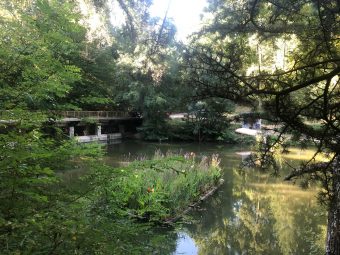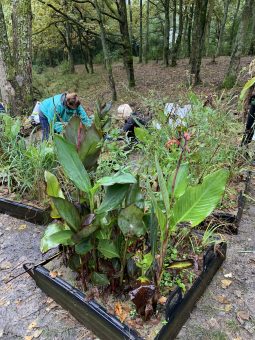
The project “Revitalization of the lake at the locality of Trešnja by the System of floating islands” has been recognized on several occasions as an example of good practice, both by the domestic and international scientific community. The project was realized from 2018 to 2020, and the financier is the Secretariat for Environmental Protection of Belgrade, while the executor is the Institute of Forestry from Belgrade.
The main goal of the project is to enable the treatment of polluted lake water in a completely natural way, without the use of chemicals and additional energy, which could further endanger the environment and human health. This goal was achieved by setting up and validating a predefined floating island model, which can be further used to revitalize lakes and rivers as a powerful nature-based solution for a sustainable and resilient society. We talked to Nevena Čule, PhD, one of the project managers, about how the project was conceived and then realized.
EP: How does the System of floating islands work and how is it implemented at the mentioned site?
Nevena Čule: Floating islands are a green technology based on plants, which have the ability to remove excess nutrients and heavy metals from surface waters under different conditions. By imitating natural processes, without the use of chemicals or additional energy, and thanks to the symbiotic relationships of its basic components, i.e. plants, algae, small invertebrates, zooplankton, microorganisms, substrate and water, this green technology enables the revitalization of polluted and wastewater treatment. Plants can accumulate various substances characterized as water pollutants, translocate them and store them in their tissues. The amount of intake and storage of nutrients, heavy metals and other substances depends on the plant species and the concentration of these pollutants in water and is positively correlated with the overall efficiency of the biological system.
Microorganisms, which are located in the rhizosphere of plants, remove large amounts of organic carbon, heavy metals, nutrients and other substances from their water, and it also affects the reduction of the number of pathogenic microorganisms. The floating islands themselves are square in shape, measuring 1×1 meter, which allows easy connection of islands to the System, their easy anchoring, makes it easier to make island carriers and reduces the possibility of retaining various solid waste within the System.
In fokus:
EP: Is this the first time such a system has been implemented?
Nevena Čule: The model of floating islands, which was used for the revitalization of the lake, is the result of my awarded doctoral dissertation and the project of revitalization of the Topčiderska river. After research conducted in the laboratory and within the pilot plant, this was the first time that floating islands were used in practice, in a real environment. The proposed model of floating islands has the character of an innovative technology, because so far in Serbia it has not been used for purification and revitalization of polluted waters. Also, based on the conducted research and review of scientific-professional and relevant literature on the existing types of floating islands, it was concluded that such a model in terms of construction of the lattice girder, substrate, composition of island vegetation and anchoring methods was not constructed in the world or in our country.

EP: How do you assess suitable sites for the application of such a system and why was Trešnja selected?
Nevena Čule: Further development of all biological methods for wastewater treatment, including floating islands, must move in the direction of their commercialization. The two biggest obstacles to achieving this goal are their non-recognition in the laws and other relevant regulations of the Republic of Serbia and the lack of financial resources to support and invest in such environmental projects, although they have multiple significance for the whole community. One of the first steps to overcome these problems is to create examples of good practice, which can attract investors for further projects and enable changes in laws and regulations. The first systems of floating islands should be installed in important locations for the city and its inhabitants, noting that it is desirable to choose waters with low to moderate concentrations of pollutants. The lake at the Trešnja site, based on the project “Revitalization of the Topčiderska river with biological systems for purification of polluted waters”, is marked as one of the potential areas for setting up biological systems for purification and revitalization of polluted waters, because it has some of the listed characteristics. This lake is about 35 kilometers away from the center of Belgrade and is located within the forest complex Trešnja. Thirty years ago, the site was a very popular picnic area, and today the lake is polluted with municipal waste and fecal wastewater, because in the meantime, just above the bank of the stream, whose waters fill the lake, built numerous weekend facilities with illegal septic tanks and field toilets whose contents flows into the streambed polluting the entire environment. The lake has a landscaped shore and water with low to moderate concentrations of pollutants, and since water of excellent ecological status is one of the most desirable natural elements of any resort, revitalization of the lake has multiple significance for this locality and could become a central factor in recovering a forgotten resort in the immediate vicinity of Belgrade.
EP: What results do you expect from this project?
Nevena Čule: The main goal of the Project is to enable the treatment of polluted lake water in a completely natural way, which will be efficient, environmentally friendly and economically viable. The results at the end of the research showed that the floating islands additionally enriched the lake water with oxygen and had excellent potential for reducing electrolytic conductivity and chemical oxygen demand as well as concentrations of nitrite, nitrate, total nitrogen, total phosphates and suspended solids. Also, the floating islands removed aluminum, arsenic, boron, barium, calcium, cobalt, chromium, iron, magnesium, manganese, lead, sulfur and zinc from the water with great efficiency. Achieved pollutant removal efficiencies are between 30 and 100 percent depending on the type of pollutant. The analysis of sanitary-microbiological parameters for the assessment of the ecological quality of water concluded that the floating islands reduced the number of bacteria of fecal origin in the range from 97 to 100 percent. The obtained results indicate that the water in the immediate vicinity of the floating islands had the characteristics of water of class I, i.e. excellent ecological status.
Interview by: Jovana Canic
Read the whole interview in the new issue of the Energy portal Magazine SMART CITIES, december 2020 – february 2021.

